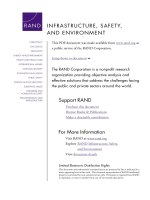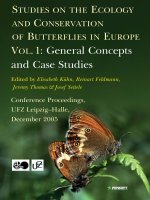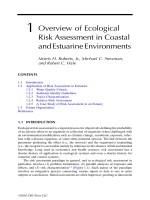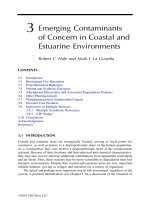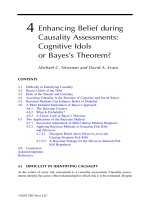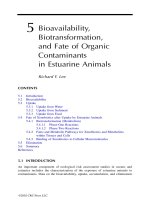Case studies dietary risk assessment dec 13 compatibility mode
Bạn đang xem bản rút gọn của tài liệu. Xem và tải ngay bản đầy đủ của tài liệu tại đây (38.28 KB, 6 trang )
12/9/2010
1
Chlorpyrifos
CI
C
I
CI
N
O
O
OC
2
H
5
C
2
H
5
P
Chlorpyrifos is an organophosphorus
insecticide used for the control of various
crop pests in soil and on foliage, household
pests and aquatic larvae.
C
N
S
2
5
Physiochemical Properties
Vapour pressure 2.49 x 10
-3
Pa at 25
0
C
Water Solubility 2 mg/L at 25
0
C
Log octanol-water 4.82 - 5.11 (high)
partition coefficient
tightly absorbed by soil and is not expected to leach
si
g
nificantl
y
gy
persists in soil for 60 to 120 days
rate of hydrolysis in water with pH and temperature, and is
enhanced by the presence of copper
between 30 and 60% of the total amount of chlorpyrifos in an
aqueous phase may disappear within 24 hours, through
adsorption, degradation and vaporization
Residue limits have been set for exposure to
chlorpyrifos through both food and water by a
Chlorpyrifos Exposure
series of laboratory exposure studies
General Toxicology of Chlorpyrifos
chlorpyrifos is a cholinesterase inhibitor
it is readily absorbed from the gastrointestinal
tract and is rapidly metabolized
metabolites are excreted in the urine and to a
lihf
l
esser extent
i
n t
h
e
f
eces
the main metabolites are 3,5,6-trichloro-2-
pyridylphosphate and 3,5,6-trichloro-pyridinol
small amounts of unmetabolized chlorpyrifos have
been detected in the blood, brain, and liver after
accidental human ingestion
12/9/2010
2
Toxicological Studies
Teratogenicity/Reproduction
chlorpyrifos was not teratogenic to mice at doses up to
and including 25 mg/kg bw/day, although severe
maternal toxicity and fetotoxicity were evident at that
dose
some malformations were observed among litters of
mice given 1 mg/kg chlorpyrifos; however, a dose-
related teratogenic response was not observed, nor
repeated in additional mice given the same dose
no evidence of a teratogenic response was observed in
mice given 0.1, 1, 10 or 25 mg/kg of chlorpyrifos during
the critical period of organogenesis
From Deacon et al 1979
Teratogenicity/Reproduction
reproduction performance was not affected by
chlorpyrifos at any dose level administered to mice
fetotoxicity, as evidenced by increased occurrence of
minor skeletal variants, and decreased fetal body
weight measurements was noted at a dose level of 25
/k d i i
mg
/k
g
d
ose
i
n m
i
ce
Neurotoxicity
groups of rats were administered chlorpyrifos orally at
dosage levels of 0, 0.5, 1, 5, 10, 50 or 100 mg/kg/day
28- 40% plasma cholinesterase inhibition (ChEI) was
observed 3-6 hours post exposure with chlorpyrifos
doses of 1 mg/kg/day or higher
Significant brain ChEI was observed with doses of
Significant
brain
ChEI
was
observed
with
doses
of
greater than 10 mg/kg/day
The NOAEL was determined to be 0.5 mg/kg/day
Neurotoxicity
groups of adult hens were administered chlorpyrifos
orally at dosage levels of 0, 25, 50, 100, 200 or 400 mg/kg
bw/day, with atropine (30 mg/kg) being given to all birds
prior to dosing
there were dose-dependent, acute cholinergic effects
observed for the chlorpyrifos treated groups. Symptoms
ildd
i
nc
l
u
d
e
d
:
- transient signs of ataxia
- CNS depression and paralysis (reversible)
histologic evaluation revealed no evidence of neurotoxic
effects in chlorpyrifos treated hens
the acute dose of 100 mg/kg bw/day of chlorpyrifos did
not induce a delayed neurotoxic response in hens
12/9/2010
3
Carcinogenicity
groups of CD-1 mice were fed chlorpyrifos in the diet at dosage
levels of 0, 0.05, 0.5 and 1.5 mg/kg/day for a period of 105 weeks
histological examination revealed a significant difference between
control and mid-dose males for the incidence of hyperplastic
nodules of the liver
there was a significant increase in the incidence of spindle cell
hyperplasia of the adrenal gland for male mice at low and mid-dose
levels, and in female mice at low dose
there were no other significant lesions or increased hyperplastic
and/or nodular lesions
the results of this study demonstrate that chlorpyrifos is not
oncogenic in mice at a dietary level up to and including 1.5
mg/kg/day
human volunteers were administered oral doses of
0.014 mg/kg bw/day of chlorpyrifos for 27 days, 0.03
mg/kg bw/day for 20 days or 0.10 mg/kg bw/day for
nine days
red blood cell cholinesterase activity was not
affected at any level
Short-Term Toxicity
affected
at
any
level
in a more recent study, human volunteers were administered a
single 0.5 mg/kg oral dose of chlorpyrifos, followed two or more
weeks later by a 0.5 or 5.0 mg/kg dermal dose of chlorpyrifos
no signs or symptoms of toxicity or changes in erythrocyte
cholinesterase were observed
plasma cholinesterase was depressed to 15% of predose levels by
Short-Term Toxicity
plasma
cholinesterase
was
depressed
to
15%
of
predose
levels
by
the 0.5 mg/kg oral dose, but was essentially unchanged following
the 5.0 mg/kg dermal dose
0.5 mg/kg was considered a NOE(A)L for cholinergic signs in
humans, because all studies in laboratory animals indicate that
extensive inhibition of both RBC and plasma cholinesterase occur
before there are any actual expressions of cholinergic signs
Beagle dogs were fed diets containing chlorpyrofos at
dose levels of 0, 0.01, 0.03, 0.1, 1, or 3 mg/kg bw/day for
two years
red blood cell cholinesterase was inhibited in males and
females at 0.1, 1.0 and 3.0 mg/kg bw/day
in a similar study, rats were fed diets containing
Chronic Toxicity
in
a
similar
study,
rats
were
fed
diets
containing
chlorpyrifos at concentrations of 0, 0.01, 0.03, 0.1, 1 and
3 mg/kg bw/day for two years
brain cholinesterase activity was inhibited at 3.0 mg/kg
bw/day, and slightly depressed at 1.0 mg/kg bw/day
based on these results, the no-observed-adverse- effect
level (NOAEL) for red blood cell and brain cholinesterase
inhibition is considered to be 0.1 mg/kg bw/day
12/9/2010
4
Chlorpyrifos Study NOAEL Endpoint
mg/kg/day
Short-term toxicity (human) 0.1 AChE depr.
(human) 0.5 Chol. Symp.
(monkey) 0.1 AChE depr.
Chronic toxicity (dog) 0.03 AChE depr.
(rat) 0.1 AChE depr.
Reproduction (mouse) 1.0 Implantation, resorption sites
and live young
Teratology (mouse) 25 Malformations
Neurotoxicity (rats) 0.5 AChE depr.
Carcinogenicity (mouse) 1.5 Tumorgenicity
aRfD = NO(A)EL
Uncertainty Factor
The aRfD for methidathion has been derived by the U.S.
EPA as follows:
Acute Reference Dose for Chlorpyrifos
aRfD = 0.5 mg/kg/day
100
where:
0.5 mg/kg/day is the NOAEL derived from the
neurotoxicity study in rats
100 is the uncertainty factor
= 0.005 mg/kg/day
Acute Population Adjusted Dose
for Chlorpyrifos
The EPA found that in the case of chlorpyrifos the
default FQPA Safety Factor of 10 was required
Therefore, the acute Population Adjusted Dose (aPAD)is:
aPAD = aRfD
10
= 0.005 mg/kg/day
= 0.0005 mg/kg/day
10
cRfD = NO(A)EL
Uncertainty Factor
The cRfD for chlorpyriofs has been derived by the U.S.
EPA as follows:
Chronic Reference Dose for Chlorpyrifos
cRfD = 0.03 mg/kg/day
100
where:
0.03 mg/kg/day is the NOAEL derived from the chronic
toxicity study in dogs
100 is the uncertainty factor
= 0.0003 mg/kg/day
12/9/2010
5
Chronic Population Adjusted
Dose for Chlorpyrifos
Once again the FQPA Safety Factor of 10 has been
applied in calculating the chronic Population Adjusted
Dose (cPAD)
cPAD = aRfD
10
= 0.0003 mg/kg/day
= 0.00003 mg/kg/day
10
Acute Dietary Risk Assessment
A revised acute dietary risk analysis was conducted
with the DEEM
The exposure at a maximum was to children (1-6 years
old) - 0.00041 mg/kg/day (99.9
th
percentile of exposure)
aPAD = 0.0005 mg/kg/day and the
Maximum 99.9
th
percentile of exposure (acute food
exposure) = 0.00041 mg/kg/day
aPAD >
Acute food exposure, therefore the use is considered
safe.
Chronic Dietary Risk Assessment
A chronic dietary risk analysis was conducted using the
DRES analysis
Using DRES, the Theoretical Maximum Daily Intake
(TMDI) was calculated, however it did incorporate data
from % treated crop, anticipated residue data and
market basket surve
y
data
cPAD = 0.00003 mg/kg/day and the
TMDI = 0.0000153mg/kg/day
PAD >
TMDI, therefore the use is considered safe.
y
Dietary Risk from Drinking Water
• The EPA determines the dietary risk based on
modeling or from monitoring data from both surface
and ground water
• To determine the maximum allowable contribution
of water
-
containing pesticide residues permitted in
of
water
containing
pesticide
residues
permitted
in
the diet, EPA first looks at the risk from food and
then determines a “drinking water level of
comparison” (DWLOC) to determine whether
modeled or monitoring levels exceed this level
• The DWLOC is the maximum concentration in
drinking water which, when considered together
with food exposure, does not exceed the PAD
12/9/2010
6
• For acute risk, the potential drinking water exposure
derived from either ground or surface water was
modeled resulting in an Estimated Environmental
Concentration (EEC) of 0.4 ppb for surface water
• Actual concentrations of chlorpyrifos in surface water
and finished drinkin
g
water are likel
y
to be less
Acute Risk from Drinking Water
gy
Acute Risk from Drinking Water
Calculating the DWLOC
DWLOC = aPAD – acute food exposure
=
0 0005
–
0 00041
(child 1
-
6yrs)
0
.
0005
0
.
00041
(child
,
1
6
yrs)
= 0.00009 mg/kg/day or 0.9 ppb
In comparing the DWLOC (0.9 ppb) with the EEC (0.4 ppb):
DWLOC > EEC, therefore the use is considered to be safe
Chronic Risk from Drinking
Water
• For chronic risk, the potential drinking water exposure
derived from either ground or surface water was
modeled resulting in an Estimated Environmental
Concentration
(
EEC
)
of 0.026
pp
b for surface wate
r
()
pp
Chronic Risk from Drinking
Water
Calculating the DWLOC
DWLOC = cPAD – chronic food exposure
=
0 00003
–
0 0000153 (child 1
-
6yrs)
0
.
00003
0
.
0000153
(child
,
1
6
yrs)
= 0.0000147 mg/kg/day or 14.7 ppb
In comparing the DWLOC (14.7 ppb) with the EEC (0.026 ppb):
DWLOC > EEC, therefore the use is considered to be safe

